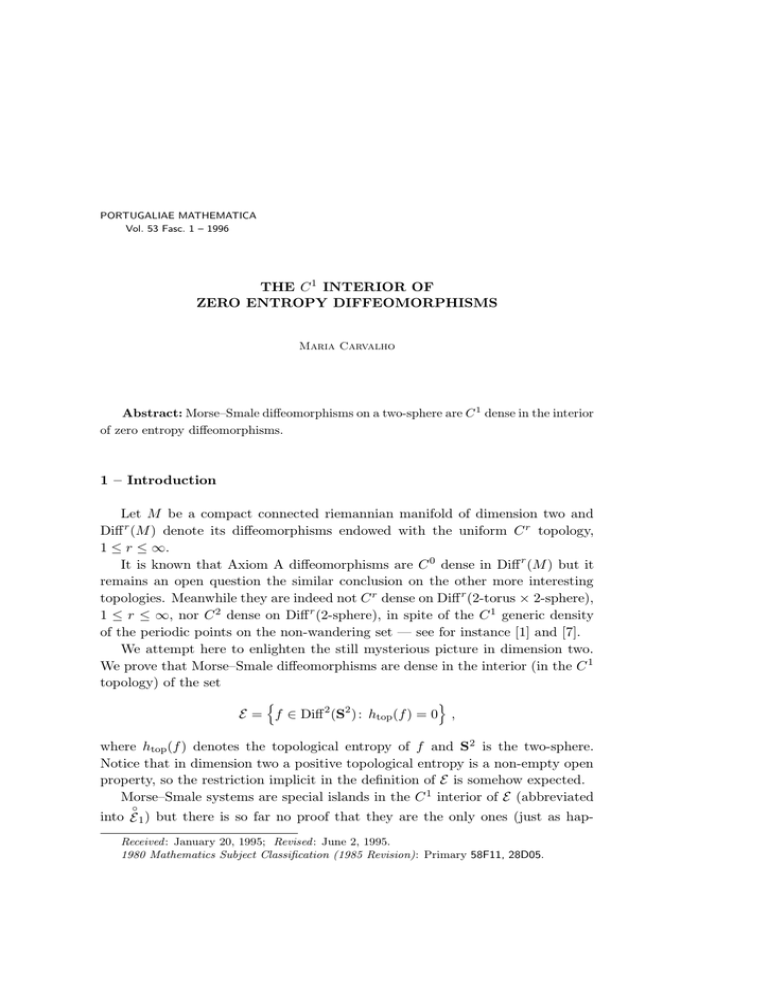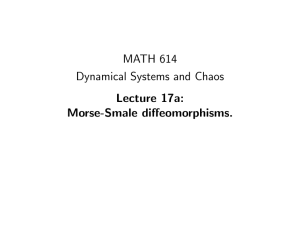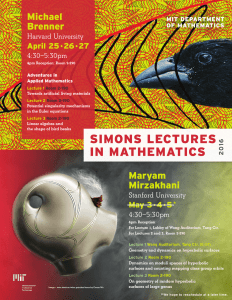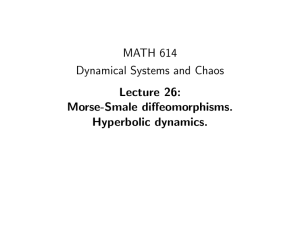THE C INTERIOR OF ZERO ENTROPY DIFFEOMORPHISMS
advertisement

PORTUGALIAE MATHEMATICA
Vol. 53 Fasc. 1 – 1996
THE C 1 INTERIOR OF
ZERO ENTROPY DIFFEOMORPHISMS
Maria Carvalho
Abstract: Morse–Smale diffeomorphisms on a two-sphere are C 1 dense in the interior
of zero entropy diffeomorphisms.
1 – Introduction
Let M be a compact connected riemannian manifold of dimension two and
Diff r (M ) denote its diffeomorphisms endowed with the uniform C r topology,
1 ≤ r ≤ ∞.
It is known that Axiom A diffeomorphisms are C 0 dense in Diff r (M ) but it
remains an open question the similar conclusion on the other more interesting
topologies. Meanwhile they are indeed not C r dense on Diff r (2-torus × 2-sphere),
1 ≤ r ≤ ∞, nor C 2 dense on Diff r (2-sphere), in spite of the C 1 generic density
of the periodic points on the non-wandering set — see for instance [1] and [7].
We attempt here to enlighten the still mysterious picture in dimension two.
We prove that Morse–Smale diffeomorphisms are dense in the interior (in the C 1
topology) of the set
n
o
E = f ∈ Diff 2 (S2 ) : htop (f ) = 0 ,
where htop (f ) denotes the topological entropy of f and S2 is the two-sphere.
Notice that in dimension two a positive topological entropy is a non-empty open
property, so the restriction implicit in the definition of E is somehow expected.
Morse–Smale systems are special islands in the C 1 interior of E (abbreviated
◦
into E 1 ) but there is so far no proof that they are the only ones (just as hapReceived : January 20, 1995; Revised : June 2, 1995.
1980 Mathematics Subject Classification (1985 Revision): Primary 58F11, 28D05.
90
M. CARVALHO
◦
pens among Diff r (S1 )) or even if E is the C 1 closure of E 1 , due to a still weak
understanding of the bifurcation processes possible within E.
2 – Preliminaries
For f ∈ Diff r (M ), a point x ∈ M is non-wandering if for each neighbourhood
U of x there is a positive integer N such that f N (U) ∩ U 6= ∅. In the sequel the
set of non-wandering points of f will be denoted by Ω(f ).
A diffeomorphism f satisfies the Axiom A if
a) Ω(f ) has a hyperbolic structure;
b) the periodic points, Per(f ), are dense in Ω(f ).
In compact manifolds without boundary of dimension two, this definition is
repetitive since
Lemma 1. In dimension two, [Ω(f ) hypebolic ⇒ Ω(f ) = closure (Per(f ))].
Proof: A brief sketch o the argument given in [8] follows as this: let f be
a diffeomorphism whose non-wandering set is hyperbolic; then its limit set is the
closure of the periodic points and has a spectral decomposition in basic sets. This
decomposition turns out to be the one of Ω(f ).
Morse–Smale diffeomorphisms are the ones with finite non-wandering set
which has only periodic hyperbolic orbits, whose stable and unstable manifolds
intersect transversally.
2 – The C 0 topology
Let E be the set {f ∈ Diff 2 (M ) : htop (f ) = 0}. The interior of E in this
topology turns to be empty, since, for example, we may construct a family of
diffeomorphisms on the two-sphere with topologically very thin horseshoes C 0
approaching a saddle.
Lemma 2. Axiom A diffeomorphisms are C 0 dense in Diff r (M ).
Proof: Given f in Diff r (M ), the construction of g satisfying Axiom A and
C 0 close to f depends on a clever triangulation of the manifold whose simplexes
define a filtration for some isotopy transform If of f . By surgery, If appears
THE C 1 INTERIOR OF ZERO ENTROPY DIFFEOMORPHISMS
91
with hyperbolic limit set and without cycles. See [9] and [10] for details.
Choose f in E. By Lemma 2, we may find g satisfying the Axiom A which is
C 0 close to f .
Lemma 3.
finite.
If g belongs to E ∩ {Axiom A}, then its non-wandering set is
Proof: As g is Axiom A and has zero topological entropy, the spectral
decomposition of Ω(g) in basic sets Ω(g) = Λ1 ∪ Λ2 ∪ ... ∪ Λs does not allow a Λi
with infinitely many points. In fact we would have in such a Λi , according to the
equivalence relation that determines the spectral partition, subsets contributing
to positive entropy: homoclinic intersections of invariant manifolds producing
horseshoes.
Lemma 4. In the hypothesis of Lemma 3, g may be C 1 approximated by a
Ω-stable diffeomorphism G such that Ω(G) = Ω(g).
Proof: Since the non-wandering set of G is hyperbolic and finite, Theorem B
from [8] assures the existence of G. Notice that, as Ω(g) is finite, htop (G) = 0;
moreover G is in the C 1 interior of E due to the invariance of the entropy by
topological conjugacy.
Lemma 5. G is a Morse–Smale diffeomorphism.
Proof: The missing property, that is, the transversality of the intersections
between stable and unstable manifolds of elements of Ω(G), is ensured by Theorem 2 of [5].
It is not known whether we may find a diffeomorphism with zero entropy but
not C 0 close to one satisfying Axiom A and whose topological entropy is zero.
However if f has zero entropy and satisfies Axiom A, we may conclude that f is
C 0 approximated by a Morse–Smale diffeomorphism, in account of the fact that
C 1 closeness yields C 0 closeness. Hence
Theorem A.
i) Morse–Smale diffeomorphisms are C 1 dense in E∩{Axiom A diffeomorphisms}.
ii) Morse–Smale diffeomorphisms are C 0 dense in the C 0 closure of the set
E ∩ {Axiom A}.
92
M. CARVALHO
4 – The C 1 topology and the two-sphere
Recall that a diffeomorphism possesses a homoclinic tangency if one of its
periodic hyperbolic points has stable and unstable manifolds intersecting nontransversally.
The peculiarities of the two-sphere already intervened in [7] — where geometric properties of invariant subsets, inducing persistence of non-hyperbolic
non-wandering points, imposed topological restrictions in Diff(S2 ) — and in
[6] through the possibility of promoting almost homoclinic orbits to homoclinic
points, which makes extensive use of the Jordan curve theorem.
Lemma 6. Let f be a C 2 diffeomorphism of the two-sphere with all periodic
points hyperbolic and infinitely many. Then f can be approximated in the C 1
topology by a diffeomorphism with homoclinic points.
This Lemma is the main result in [6] and depends on recent progress due to
Araújo and Mañé on the understanding of the asymptotic behaviour of diffeomorphisms on manifolds of dimension two, [3].
A stronger property on periodic hyperbolic orbits of a diffeomorphism is the
key for the following Lemma. We denote by F 1 (M ) the C 1 interior in Diff 1 (M )
of the family of diffeomorphisms with all periodic points hyperbolic.
Lemma 7. f ∈ F 1 (M ) ⇒ f satisfies Axiom A.
This has been established in [2], emerging from the ideas of Mañé which led
to the proof of the stability conjecture.
◦
Let E 1 be the set {f ∈ Diff 2 (M ) : ∃ V neighbourhood of f in the C 1 topology
◦
such that V ⊆ E}. Notice that E 1 is non-empty, contrary to what happens with
the C 0 interior of E, since it contains all Morse–Smale systems.
◦
Theorem B. Morse–Smale diffeomorphisms on the two-sphere are dense in
E 1.
◦
Proof: Let f be an element of E 1 and V a C 1 neighbourhood of f contained
in E. We may approximate f by F in V such that all periodic points of F are
hyperbolic, since Kupka–Smale systems are C r generic. As F belongs to V, it
has zero topological entropy.
THE C 1 INTERIOR OF ZERO ENTROPY DIFFEOMORPHISMS
93
If F satisfies Axiom A then, by Lemma 3, the non-wandering set of F is
finite and, by Lemmas 4 and 5, F may be C 1 approximated by a Morse–Smale
diffeomorphism, yielding the theorem for the given f .
If F does not satisfy Axiom A then, by Lemma 1, this occurs because Ω(F ) is
not hyperbolic. But the set of periodic points of F , say Per(F ), is hyperbolic and
must be finite by Lemma 6: if not, we could find a diffeomorphism H in V exhibiting a generic homoclinic tangency whose unfolding would produce an element H 1
in V with positive entropy. But if Per(F ) is hyperbolic and finite, then F belongs
to the interior of the subset of Diff 1 (M ) with all periodic points hyperbolic. By
Lemma 7 this implies that F satisfies Axiom A, which is a contradiction.
In particular we proved that
◦
Corollary. Generically in E 1 all diffeomorphisms satisfy Axiom A.
5 – Other manifolds of dimension two
The conclusions in this context are less mature then the ones in the previous
section, apart from the major work on the dynamics in dimension two achieved
in [3] and which reads as follows:
Lemma 8. Let f be a C 2 diffeomorphism on a manifold M with dimension
two with all periodic points hyperbolic. Then one of the following assertions is
true:
i) f possesses a finite number of hyperbolic attractors and contracting irrational rotations, say A1 , ..., An , and a finite number of hyperbolic repellers
and expanding irrational rotations, say R1 , ..., Rm , such that for Lebesgue
almost every point in M its α-limit lies in Rj for some j and the ω-limit
lies in Ak for some k;
ii) f is C 1 close to a diffeomorphism which exhibits a homoclinic tangency.
Recall that a hyperbolic attractor of f ∈ Diff r (M ) is a transitive hyperbolic
invariant set having a neighbourhood U such that the closure of f (U) is contained
in U and the attractor is the intersection of the positive iterates of U by f . Simple
examples are the attracting periodic orbits, usually called sinks.
94
M. CARVALHO
Following [3], we say that Λ is a contracting irrational rotation of f if
• Λ is homeomorphic to a circle and is invariant by an iterate N of f (hence
f N |Λ has zero topological entropy);
• f N is conjugate to an irrational rotation;
• the tangent bundle of M restricted to Λ has a continuous Df N invariant
splitting into a direct sum E ⊕ T Λ such that kDf N |E(x) k < 1 for all x in Λ.
Analogous definitions for hyperbolic repellors, sources and expanding irrational rotations.
Definition. We say that f ∈ Diff r (M ) is an almost Morse–Smale diffeomorphism if Lebesgue almost every point in M has its α-limit in a source and its
ω-limit in a sink and these are finitely many.
◦
A straight corollary of Lemma 8 reduces the possible features in E 1 to the
following description:
◦
Theorem C. The almost Morse–Smale systems are dense in E 1 .
Notice that for each C 2 Axiom A diffeomorphisms there is at least one attractor and moreover Lebesgue almost all point of the manifold has its ω-limit in the
(finite) family of the attractors — see for instance [4]. The lack of differentiability
obliges us to weaken this assertion among C 1 diffeomorphisms, reducing it to the
◦
topological prevalence of almost Morse–Smale systems in E 1 .
◦
Proof: As in the proof of Theorem B, we may start with an element of E 1
whose periodic points are all hyperbolic. We have already remarked that the
◦
◦
assertion ii) of Lemma 8 is impossible within E 1 . If f is in E 1 , it cannot have
hyperbolic non-trivial attractors or repellors, since these are necessarily of Plyckin
type and so contribute to positive topological entropy. Therefore f can only have
a finite number of sinks and sources, besides the finite number of contracting
or expanding irrational rotations. Moreover, these kind of rotations are not C r
◦
generic, so we may C 1 approximate f by another element of E 1 whose physically
observable dynamics (that is, the asymptotic behaviour of Lebesgue almost every
orbit) are sources and sinks as described in Lemma 8 i). Therefore f is C 1 close
to an almost Morse–Smale system as claimed.
THE C 1 INTERIOR OF ZERO ENTROPY DIFFEOMORPHISMS
95
REFERENCES
[1] Abraham and Smale – Nongenericity of Ω-stability, Global Analysis, XIV (1970),
5–8.
[2] Aoki – The set of Axiom A diffeomorphisms with no cycles, Bol. Soc. Bras. Mat.,
23(1–2) (1992), 21–66.
[3] Araújo and Mañé – Asymptotic properties of C 1 generic diffeomorphisms of
surfaces, Preprint IMPA, 1992.
[4] Bowen – Equilibrium states and ergodic theory of Anosov diffeomorphisms, Lecture Notes in Math., 470, Springer-Verlag.
[5] Franks – Necessary conditions for stability of diffeomorphisms, Trans. Amer.
Math. Soc., 158 (1971), 301–308.
[6] Gambaudo and Rocha – Maps of the two-sphere at the boundary of chaos,
Nonlinearity, 7(4) (1994), 1251–1260.
[7] Newhouse – Nondensity of Axiom A(a) on S 2 , Global Analysis, XIV (1970),
191–202.
[8] Newhouse and Palis – Hyperbolic nonwandering sets on two-dimensional manifolds, in “Dynamical Systems” (M. Peixoto, ed.), Academic Press, 1973, 293–301.
[9] Shub – Structurally stable diffeomorphisms are dense, Bull. Amer. Math. Soc., 78
(1972), 817–818.
[10] Smale – Stability and isotopy in discrete dynamical systems, Proc. Symp. Univ.
Bahia (1971), 527–530.
Maria Carvalho,
Grupo de Matemática Pura,
Universidade do Porto, 4050 Porto – PORTUGAL
E-mail: mpcarval@fc1.fc.up.pt





